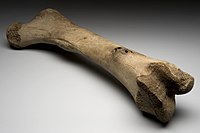
Photo from wikipedia
BACKGROUND As glenoid failure is one of the primary causes of failure of anatomic total shoulder arthroplasty (TSA), Trabecular Metal-backed glenoid components have become popular. This study reports implant survival… Click to show full abstract
BACKGROUND As glenoid failure is one of the primary causes of failure of anatomic total shoulder arthroplasty (TSA), Trabecular Metal-backed glenoid components have become popular. This study reports implant survival and clinical outcomes of patients who received a Trabecular Metal-backed glenoid component during primary anatomic TSA. METHODS Patients who underwent TSA with a Trabecular Metal-backed glenoid component by a single surgeon were identified and reviewed for clinical, radiographic, and patient-reported outcome measures with a minimum of 2 years' follow-up. RESULTS Of 47 patients identified, radiographic and clinical follow-up was available on 36 patients (77%). Average age was 66.36 years (range, 50-85 years), and the average follow-up 41 months (range, 24-66 months). Three patients showed signs of osteolysis, 4 had radiographic evidence of metal debris, and 1 patient had a catastrophic failure after a fall. Of the 47 TSAs, 5 (11%) were revised to a reverse TSA for subscapularis failure and pain. Visual analog scale for pain scores improved by an average of 4.4. At final follow-up, the average Single Assessment Numeric Evaluation score was 72.4; Penn satisfaction score, 7.5; Penn score, 70.35; and American Shoulder and Elbow Surgeons score, 69.23. Outcome scores were similar in the 7 patients with osteolysis or metal debris compared to those without. CONCLUSION Trabecular Metal-backed glenoids had a 25% rate of radiographic metal debris and osteolysis at a minimum 2-year follow-up in this series with one catastrophic failure. This implant should be used with caution, and patients followed closely.
Journal Title: Journal of shoulder and elbow surgery
Year Published: 2018
Link to full text (if available)
Share on Social Media: Sign Up to like & get
recommendations!